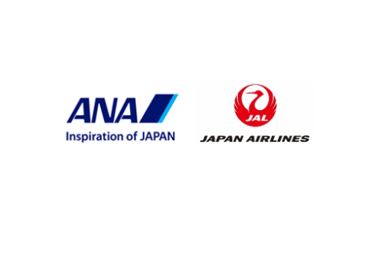(Joint Release)
• ANA and JAL have developed a joint report “Toward Virtually Zero CO2 Emissions from Air Transport in 2050,” with the aim of expanding awareness and promoting understanding of Sustainable Aviation Fuel.
• The two airlines will work together to raise awareness on the production and usage of SAF, as well as the importance of air transportation as critical social infrastructure connecting Japan and the world for future
generations.
• ANA and JAL will work together with the Japanese government and other interested parties to promote SAF,
while cooperating to promote other environmental measures also.
• Both companies are committed to protecting the environment through reducing carbon emissions and contributing to the sustainable growth of the Japanese economy.

TOKYO, October 8, 2021 – All Nippon Airways (ANA) and Japan Airlines (JAL), have published a joint report on the promotion and viability of Sustainable Aviation Fuels (hereinafter “SAF”), which are expected to become central to the airlines’ shared goal of achieving carbon neutrality in air transportation by 2050.
In the report, “Toward Virtually Zero CO2 Emissions from Air Transport in 2050,” the companies have jointly
assessed the benefits and features of SAF and the amount of SAF that would be required to support full
adoption by the aviation industry. The report also details the current logistical situation regarding the production, distribution, and utilization of this innovative new fuel. As part of the airlines’ joint sustainability campaign, the
study provided comprehensive analysis of the main issues facing the Japanese aviation industry as it moves
towards reduced carbon emissions. In addition to providing a roadmap to sustainability for both Japanese
airlines, the report provides information on the positive impact that this transition would have on other countries and future generations.
Key Findings:
Throughout their lifecycle, SAFs such as biomass can reduce CO2 emissions by approximately 80% compared to conventional fuels. This makes them essential for achieving full carbon neutrality by 2050 for airline industry operations. Furthermore, the full compatibility of SAFs with existing fueling equipment at airports and other infrastructure will help ease the transition towards this sustainable energy source.
The current global production of SAF is less than 0.03% against the demand, and mass production and
utilization is urgently needed. In order to achieve their ambitious environmental goals by 2050, airlines must
accelerate the technological development, production, and utilization of SAF through heightened cooperation
and collaboration with industries that are connected to the aviation sector, as well as targeting SAF use of at
least 10% by 2030.
Based on the forecasted growth rate of air transportation, the amount of SAF required in order to achieve net zero CO2 emissions by 2050 for domestic and international flights by Japanese airlines and for foreign airlines operating in Japan is estimated to be 2,300 million kL.
The production and commercialization of SAF in Asia is still in its early stages compared to Europe and the U.S. However, the SAF market in Asia is expected to reach approximately 22 trillion yen as air transportation demand is expected to grow significantly in the future.
During the development of the joint study, ANA and JAL renewed their commitment to achieving their shared
environmental goals. The airlines have both joined the World Economic Forum’s “Clean Skies for Tomorrow
Coalition” and co-signed the 2030 Ambition Statement, pledging to cooperate in increasing the share of SAF in the global aviation industry to 10% by 2030.

Yuji Hirako, CEO and President of ANA: We are in a situation where our generation needs to take immediate
action toward the rapidly progressing climate change. Joining together with everyone involved in the aviation
industry, we would like to pass on the blue skies to our children’s generation by steadily promoting SAF throughout the industry, and with this in mind, we have developed this report together.
Yuji Akasaka, President of JAL: The role of airlines in connecting people and building bridges between
countries will not change in the future. In order to sustain the future of aviation, the new energy of SAF and the cooperation of many people with a variety of knowledge are essential. In order to expand the circle of
cooperation, ANA and JAL will work hand to reach out to the Japanese industry.
Air transport is a critical component of the global economy, connecting people worldwide and facilitating trade
while also supporting international cultural exchange and economic growth. As demand for air travel recovers
from the disruption caused by the COVID-19 crisis, air travel will regain its significant role supporting economic growth, and SAF will emerge as a viable solution for achieving sustainable air travel. In addition, Japan’s role
as the primary hub within the growing Asian market is essential for the country to maintain its robust air network as well as its continued economic competitiveness globally. To expedite adoption, government investments in
the development, mass production, and delivery of SAF are essential. ANA and JAL will work together with a
range of stakeholders to promote SAF and will continue to contribute to Japanese society by developing a
sustainable aviation network that can address sustainability issues without passing existing problems to the
next generation.
Contact: JAL Corporate News Group Public Relations, mediarelations.hdq@jal.com
About ANA
Founded in 1952 with just two helicopters, All Nippon Airways (ANA) has grown to become the largest airline in Japan. ANA HOLDINGS Inc. (ANA HD) was established in 2013 as the largest airline group holding company in Japan, comprising 71 companies including ANA and Peach Aviation, the leading LCC in Japan.
ANA is a launch customer and the largest operator of the Boeing 787 Dreamliner, making ANA HD the biggest Dreamliner owner in the world. A member of Star Alliance since 1999, ANA has joint venture agreements with United Airlines, Lufthansa German Airlines, Swiss International Airlines, Austrian Airlines and Brussels Airlines – giving it a truly global presence.
The airline’s legacy of superior service has helped it earn SKYTRAX’s respected 5-Star rating every year since 2013, with ANA being the only Japanese airline to win this prestigious designation for eight consecutive years. ANA also has been recognized by Air Transport World as “Airline of the Year” three times (2007, 2013 and 2018); it is one of only a select few airlines to win this prominent award multiple times.
In 2021, ANA was awarded the 5-star COVID-19 safety rating by SKYTRAX, recognizing the airline’s initiatives to provide a safe, clean and hygienic environment at airports and aboard aircraft, embodied in the ANA Care Promise.
ANA is the only company in the aviation industry to receive the Gold Class distinction from the 2021 S&P Global Sustainability Awards and ANA HD has been selected as a member of the Dow Jones Sustainability World Index list for the fourth consecutive year and the Dow Jones Sustainability Asia Pacific Index list for the fifth consecutive year.
For more information, please refer to the following link: https://www.ana.co.jp/group/en/
About JAL
Japan Airlines (JAL) was founded in 1951 and became the first international airline in Japan. A member of the
oneworld® alliance, the airline now reaches 349 airports in 52 countries and regions together with its codeshare partners with a modern fleet of 230 aircraft. JAL Mileage Bank (JMB), the airline’s loyalty program, is one of the largest mileage programs in Asia. Awarded as one of the most punctual major international airlines and a certified 5-Star Airline by Skytrax, JAL is committed to providing customers with the highest levels of flight safety and quality in every aspect of its service, and one of the most preferred airlines in the world.
For more information, please refer to the following link: https://press.jal.co.jp/en/release/202110/006238.html
At the general shareholders’ meeting held in June 2020, the company set a target of net zero CO2 emissions by 2050 and incorporated the acceleration of its response to climate change into the 2021 -2025 JAL Group Medium-Term Management Plan.
The JAL Group’s target for 2030 to keep total emission below 90% level of that of fiscal year 2019 is one of the most ambitious targets for airlines around the world. The Group will strive to achieve our goals by steadily upgrading to the latest aircrafts based on stable financial base, reducing CO2 emissions in daily operations through the promotion of JAL Green Operations, and expanding SAF load.
For more information, please refer to the following link:https://www.jal.com/en/sustainability/environment/climate-action/
The JAL Group is also actively investing in SAF, using it on scheduled flights, and disseminating information in order to become the leading airline in the adoption of SAF. In September 2018, the JAL Group, acquired a
stake in Fulcrum Bio Energy, Inc. (“Fulcrum”) located in California, USA. This was the first investment by a
Japanese company in an SAF manufacturing business. the JAL Group will strengthen its relationship with
Fulcrum and proceed with refueling our aircraft with SAF supplied by Fulcrum, mainly on flights departing from North America, in order to reduce CO2 emissions.
On February 4, 2021, JL319 took off from Tokyo Haneda, bound for Fukuoka, using sustainable aviation fuel
(SAF) produced with Japanese technology. Using cotton obtained from donated clothing, this and other such SAFs can have a great impact on the reduction of CO2 emissions from airplanes. At Japan Airlines, the heart of our service is Omotenashi, known as the warmth of Japanese hospitality. Your journey to Japan and authentic Omotenashi starts with your flight on Japan Airlines.
For more information, please refer to the following link:
https://www.jal.com/en/sustainability/environment/climate-action/saf/



